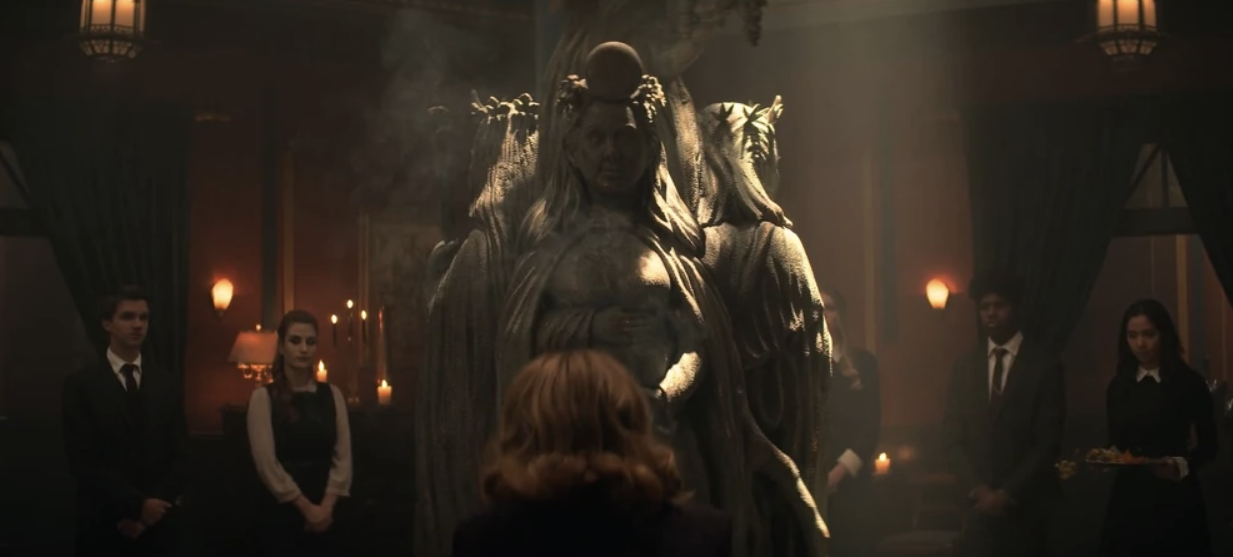Hecate

| Basic Information | |
|---|---|
| Species | Goddess |
| Type | Triple Goddess: Maiden, Mother, Crone |
| Affiliation | Order of Hecate |
| Symbols | Torches, dogs, keys, snakes |
| Mentioned | Part 3, Chapter 28; Part 4, Chapters 29, 30, 31, 32, 33, 34, 36 |
Hecate is called upon when Zelda asks the goddess for assistance in bringing Hilda back from the dead. In her invocation, she gives us some clues as to the nature of this deity. The success of this request solidifies Zelda’s decision as High Priestess of the Church of Night to change the name of the coven to the Order of Hecate. The goddess is mentioned a few other times as well, such as during Jesse Putnam’s exorcism. As the series continues, the coven finds empowerment through this female deity.
Invoking the Goddess
When Zelda calls out to Hecate to raise Hilda from the dead, we find out a few things about this goddess. She refers to her as the Triple Goddess. This idea is that Hecate has three forms: the maiden, mother, and crone. Zelda mentions that the maiden represents the potential, the mother has divine power, and the crone is wise. She says that speaking to Hecate is actually calling forth the power of all witches throughout time, since they have all descended from these three. She also calls the goddess the “keeper of the key to the door between worlds.” This is in reference to the deity’s role as a gatekeeper, someone who has access to and can grant passage between the world of the living and the world of the dead.

The Order frequently refers to Hecate as a triple goddess, but as it turns out, this isn’t the only way the ancient Greeks depicted her. In the earliest images of this goddess, she is one woman. On vase paintings, she is usually shown as a woman with two torches. Sometimes, she is a young woman wearing a skirt and hunting boots. A little bit later in Greek history, statues of the goddess show her in a triple form. Modern paganism also regards Hecate as a triple goddess.
"It is said that whenever you call on the Triple Goddess, she comes to you. As much as I ignored her, put my faith in lesser gods, signed my name in other books, she still came to me when I needed her most."
— Zelda Spellman
Hecate in Mythology
In Greek mythology, Hecate was the goddess of the night, moon, witchcraft, and necromancy. She held power over the heavens, sea, and earth and was the only child of Titans Perses and Asteria. Hecate helped Demeter search for her daughter, Persephone, when the girl was kidnapped by Hades, god of the underworld. As the goddess of boundaries, she was associated with everything from doorways to crossroads. As an underworld goddess, she held keys that could unlock the gates between the realms of the living and the dead. She was also associated with the moon and with dogs.

Hecate in Modern Paganism
In modern Pagan practices, Hecate is honored through prayers, rituals, and offerings. Since she is associated with the moon, the full moon is seen as a powerful time to call upon the goddess. Lighting candles can be a way to call in her guidance and illumination. Rituals related to transitions, choices, and new beginnings honor her role as a goddess of the crossroads. She is also revered for her protection and guidance and invoked for help when practicing divination.
Fun Facts
- Hecate is often depicted with torches, a key, or snakes.
- The goddess Hecate is also associated with the crossroads.
- Black dogs and polecats are also sometimes included in her myths.
- The lines in the invocation to Hecate given by Zelda Spellman mention her triple goddess status: "We call on you now, maiden, in your unbounded potential. We call on you, mother, in all your divine power. We call on you, crone, in your arcane wisdom."
Written by Abigail Payne
Code by Hugo Prendergast